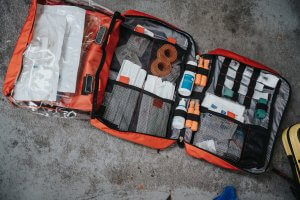
The average Emergency Medical Services response time is 7 minutes, while the average time for law enforcement officers to arrive at the scene after a 911 call is 22 minutes. Factors such as distance, traffic, weather, and other emergencies influence how quickly trained professionals can get to where their callers are. In the event of an emergency, you and the people around you will almost always have a period of time in which professional help is not present.
First aid skills do more than save lives. First aid skills shorten recovery time, decrease the chances of long term injury, and help relieve immediate discomfort. They also give you, your employees, faculty and students, or members of your congregation, confidence and security that no matter what happens, you can take care of the people you care about. Here are 3 first aid skills that could be helpful in case of an active violence emergency.
How to stop bleeding
There can be many causes as to why a person bleeds. Bleeding can be external or internal. Some cases are minor, like a nosebleed or skin graze, while others are more serious like amputation or open wounds. If medical professionals aren’t around to assess and address the bleeding or injury, it is crucial that those around you have first aid training. Taking the right steps can help reduce excessive bleeding, infection, trauma, or more damaging effects. You can stop bleeding by:
- Finding a clean cloth, some napkins, or gauze and applying direct pressure on the area that is bleeding.
- Putting more cloth, napkins, or gauze on top of the cut or wound if the first ones get soaked. Never remove the underneath layers.
- Elevating the arm, leg, or limb where the bleeding is, raising it higher than the heart to slow the bleeding.
- If possible, wear gloves or wash your hands before and after.
These are the basic and quickest things you can do when someone is bleeding during an active violence situation. If the perpetrator has already been detained or you are in a safe area and have access to an emergency kit, then you can take additional steps to help the injured people around you. If possible, you can:
- Clean the cut or wound with soap and warm water. To avoid irritation, rinse the soap out of the wound. Remember not to use hydrogen peroxide or iodine as they can damage tissues.
- Apply antibiotic ointment or cream and cover with a sterile bandage.
Cardiopulmonary Resuscitation (CPR)
There is an association between active violence and cardiovascular health. The physical and emotional stress caused by active violence can induce arrhythmia or cardiac arrest for some individuals. If an individual experiences cardiac arrest during an active shooting incident, swift action is necessary. If you wait until paramedics arrive, it might be too late for that individual to fully recover, or even survive. This is where the knowledge and skills to perform CPR are vital.
There is a common misconception that CPR is a complicated skill to acquire, necessitating extensive training and practice. In reality, there is no special certification needed, you only need to be demonstrated and educated in a simple training session. CPR doesn’t even require a tool. It’s just you, your knowledge, confidence, and ability to remain present .
Automated External Defibrillator (AED)
For an individual who has a cardiac arrest, every minute that goes by without defibrillation decreases their chances for survival by 7%-10%. An AED device assesses the patient’s heart rhythm and then administers a shock if needed through the chest wall to the heart. AEDs help restore a normal heartbeat.
Most AEDs are easy to operate. They are accurate and designed for the use of non-medical personnel. Through voice prompts, lights, and text, they guide you on what to do. However, taking part in a training on AED operation will increase your confidence and knowledge, making you more prepared if the situation were to arise during an emergency. You could be the difference between life or death if you familiarize yourself with AED devices and get training on their operations from experienced professionals.
As well as knowing how to perform first aid, you can also read about the 6 Priorities When Responding to Active Violence and increase your preparedness for responding to active violence effectively and efficiently. The most concrete way you can prepare yourself for emergencies is signing up for a Surviving Active Violence & Emergencies (SAVE) class. These classes are built specifically for and tailored to each individual group, school, or workplace and provide invaluable training on how to respond to active threats that may occur in your daily life. Always remember that quick action saves lives! Please contact us at https://inaheartbeatllc.com/contact/ to learn more about our group SAVE classes.